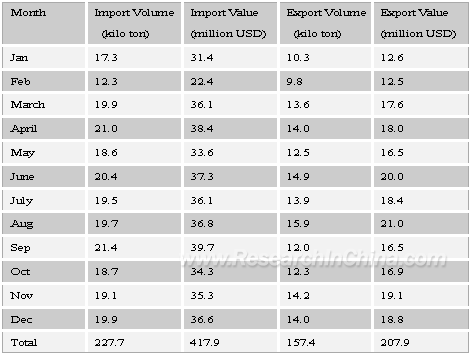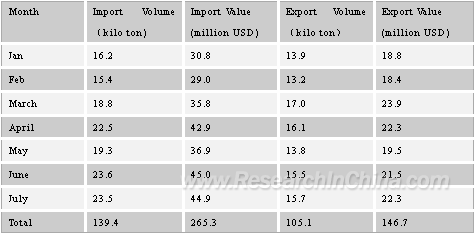| |
|
 |
Titanium dioxide, as kind of large bulk chemical material, has a close relationship with the national economy. The prosperity of economy is bound to bring a vast development space for titanium dioxide. Through four decades of development, China has become the most vigorous one in titanium dioxide industry. Especially in the recent years, with certain industry base and scale, China is now the world second largest titanium dioxide manufacturing country next to USA.
With the heating up of titanium dioxide market both at home and abroad, another prosperity cycle for this industry is forthcoming. Along with the painting industry and plastic industry see a good rising, it is estimated that in the next five years the annual consumption growth of titanium dioxide will be 2%-3% all over the world, 5%-6% in Asia-Pacific and 10%-15% in China. According to the statistics from China Customs, the import of titanium accumulated to 227.7kilo tons and the export of titanium accumulated to 157.4kilo tons in 2005.
Import &Export of Titanium Dioxide, Jan 2005-Dec 2005

Import& Export of Titanium Dioxide, Jan 2006-July 2006

Due to the strong demand, supply tends to be short. Ever since 1997, very few new factories have been built----- On the contrary, considering the profits and environmental cost, one sulfate process device was closed by each of the world top titanium dioxide manufacturers of Millennium Chemicals, Kerr McGee Corporation and UuntsmanTioxide.
A sharp price rise has fallen into global titanium dioxide market at the beginning of 2006. World major titanium dioxide manufacturers like Millennium Chemicals and UuntsmanTioxide raised their market price one after another, which brought impact to China market as well. State Environmental Protection Administration of China and the local government punished several titanium dioxide enterprises that failed to meet the waste discharging standard. Some of these enterprises were enforced to limit or stop production and some were closed down, resulted in the titanium dioxide supply more difficult.
Although China is a big manufacturing country of titanium dioxide, yet the industrial quality needs to be improved and the product structure requires to be rationalized. Most of the middle-small enterprises concentrate on low-level product; as a result, product at the high end still depends a lot on import. In the near future, it will be an inevitable trend to take steps to restructure the product, to advance the techniques and to improve the quality.
As for the overall situation, China titanium dioxide market still has a promising prospect. Enterprises that meet the environmental policy and focus on high end products have more potential to win the market.
|
|
|
|
|
If this report could not still meet your requirement, or
you have any comments or suggestions on it, please leave a
message to us.
|
2005-2007 www.researchinchina.com All Rights Reserved
| |
|
 |
| |
|
Titanium dioxide, as kind of large bulk chemical material, has a close relationship with the national economy. The prosperity of economy is bound to bring a vast development space for titanium dioxide. Through four decades of development, China has become the most vigorous one in titanium dioxide industry. Especially in the recent years, with certain industry base and scale, China is now the world second largest titanium dioxide manufacturing country next to USA.
With the heating up of titanium dioxide market both at home and abroad, another prosperity cycle for this industry is forthcoming. Along with the painting industry and plastic industry see a good rising, it is estimated that in the next five years the annual consumption growth of titanium dioxide will be 2%-3% all over the world, 5%-6% in Asia-Pacific and 10%-15% in China. According to the statistics from China Customs, the import of titanium accumulated to 227.7kilo tons and the export of titanium accumulated to 157.4kilo tons in 2005.
Import &Export of Titanium Dioxide, Jan 2005-Dec 2005

Import& Export of Titanium Dioxide, Jan 2006-July 2006

Due to the strong demand, supply tends to be short. Ever since 1997, very few new factories have been built----- On the contrary, considering the profits and environmental cost, one sulfate process device was closed by each of the world top titanium dioxide manufacturers of Millennium Chemicals, Kerr McGee Corporation and UuntsmanTioxide.
A sharp price rise has fallen into global titanium dioxide market at the beginning of 2006. World major titanium dioxide manufacturers like Millennium Chemicals and UuntsmanTioxide raised their market price one after another, which brought impact to China market as well. State Environmental Protection Administration of China and the local government punished several titanium dioxide enterprises that failed to meet the waste discharging standard. Some of these enterprises were enforced to limit or stop production and some were closed down, resulted in the titanium dioxide supply more difficult.
Although China is a big manufacturing country of titanium dioxide, yet the industrial quality needs to be improved and the product structure requires to be rationalized. Most of the middle-small enterprises concentrate on low-level product; as a result, product at the high end still depends a lot on import. In the near future, it will be an inevitable trend to take steps to restructure the product, to advance the techniques and to improve the quality.
As for the overall situation, China titanium dioxide market still has a promising prospect. Enterprises that meet the environmental policy and focus on high end products have more potential to win the market.
|
|
|
|
|
2005-2006 www.researchinchina.com All Rights Reserved |
|
| |
|
 |
| |
|
1. Operation Status of Titanium Dioxide Industry, 2005-H1 2006
1.1 Operation Circumstance
1.1.1 Policies
1.1.2 Economy Factors
1.1.3 Social Factors
1.1.4 Techniques
1.1.5 Environmental Protection Standard
1.2 Operation Status of Upstream and Downstream
1.2.1 Status Quo of the Upstream Industries
1.2.1.1 Ore (Ilmenite)
1.2.1.2 Chemical Material (Vitriol)
1.2.2 Status Quo of the Downstream Industries
1.2.2.1 Panting Industry
1.2.2.2 Plastic Industry
1.2.2.3 Paper Industry
1.2.2.4 Printing Ink Industry
1.2.2.5 Chemical Fiber Industry
1.2.2.6 Other Industries
1.3 Analysis of the Supply
1.3.1 Status Quo
1.3.1.1 Changes of Production Capacity
1.3.1.2 Changes of Output
1.3.1.3 Statistics on Manufacturers
1.3.1.4 Devices under Construction
1.3.2 Status Quo of the Industry Demand
1.3.3 Supply & Demand by Products
1.3.3.1 Titanium Dioxide Rutile Grade
1.3.3.2 Anatase Titanium Dioxide
1.3.3.3 Non-pigment Titanium Dioxide
1.4 Analysis of the Import & Export
1.4.1 Analysis of the Import
1.4.1.1 Import Volume
1.4.1.2 Statistics of Import according to the Customs
1.4.1.3 Statistics according to the Import Regions
1.4.1.4 Statistics according to the Import Countries
1.4.2 Analysis of the Export
1.4.2.1 Export Volume
1.4.2.2 Statistics of Export according to the Customs
1.4.2.3 Statistics according to the Export Regions
1.4.2.4 Statistics according to the Export Countries
1.5 Market Operation Analysis
1.5.1 Changes of Price
1.5.2 Main Factors that Affect the Market2. Development of China Titanium Dioxide Industry: Challenge and Reform
2.1 General Introduction to the Global Titanium Dioxide Industry
2.1.1 Supply in the Global Titanium Dioxide Market
2.1.1.1 Changes of the Production Capacity
2.1.1.2 Distribution of the Production capacity
2.1.1.3 Analysis of the Manufacturers
2.1.1.4 Devices under Construction
2.1.2 Demand in Global Titanium Dioxide Market
2.1.3 Market Changes
2.2 Key Factors that Promote the Development of China Titanium Dioxide Industry
2.2.1 Production Factors
2.2.2 Requirements
2.2.3 Support and Related Industries
2.2.4 Strategies, Structure and the Competition Status of Enterprises
2.2.5 National Industrial Policy
2.3 Current Development of China Titanium Dioxide Industry
2.3.1 Current Status of Titanium Dioxide Industry
2.3.1.1Market Structure
2.3.1.2 Market Behavior
2.3.1.3 Market Performance
2.3.2 Competition
2.3.2.1 Industrial Competitiveness
2.3.2.2 Price Negotiation Ability of Material Vendors
2.3.2.3 Price Negotiation Ability of Downstream Clients
2.3.2.4 Threats from the Product Replacements
2.3.2.5 Potential Threats from potential entrants
2.3.3 Advantage and disadvantage analysis
2.3.3.1 Advantages
2.3.3.2 Disadvantages
2.4 Development Trend of China Titanium Dioxide Industry
2.4.1.1 Opportunities
2.4.1.2 Challenges
2.4.2 Development Trend of Product Structure
2.4.3 Development Trend of Techniques 3. Development of China Titanium Dioxide Industry: Regional Analysis
3.1 Regional Distribution of China Titanium Dioxide Industry
3.1.1 Regional Structure
3.1.2 Regional Distribution
3.1.3 Prospect of the Industry Transference
3.2 In Sichuan province
3.2.1 Current Status
3.2.2 Analysis of the Competition
3.2.3 Development Forecast
3.3 In Guangxi Province
3.3.1 Current Status
3.3.2 Analysis of the Competition
3.3.3 Development Forecast
3.4 In Shandong Province
3.4.1 Current Status
3.4.2 Analysis of the Competition
3.4.3 Development Forecast
3.5 In Jiangsu province
3.5.1 Current Status
3.5.2 Analysis of the Competition
3.5.3 Development Forecast 4. Prospect of China Titanium Dioxide Industry, 2006-2007
4.1 Prospect of Market Environment
4.1.1 Forecast of the Macro-economy
4.1.2 Forecast of Industrial Policy
4.1.3 Factors that Affect the Market
4.2 Forecast of the Demand & Supply
4.2.1 Forecast of the Supply
4.2.2 Forecast of the Demand
4.2.3 Key Factors that Affect the Supply & Demand
4.3 Forecast of the Import & Export
4.3.1 Development trend of Import & Export
4.3.2 Factors that Affect Import & Export 5. Key Enterprises Analysis
5.1 Chongqing Titanium Industry Co., Ltd
5.1.1 Operation
5.1.2 Competition Analysis
5.1.3 Prospect Forecast
5.2 Shandong Dongjia Group
5.2.1 Operation
5.2.2 Competition analysis
5.2.3 Prospect Forecast
5.3 Sichuan LOMON Corporation
5.3.1 Operation
5.3.2 Competition Analysis
5.3.3 Prospect Forecast
5.4 Zhenjiang Titanium Dioxide Co., Ltd.
5.4.1 Operation
5.4.2 Competition Analysis
5.4.3 Prospect Forecast 6. Investment Analysis
6.1 Investment affinities
6.1.1 Major Economic Features
6.1.2 Retrospect of the Investment in Titanium Dioxide Industry
6.1.3 Valuation on the Investment return
6.1.4 Investment Environment
6.2 Investment Opportunities
6.2.1 Industrial Resources and Abilities
6.3 Investment Risks
6.3.1 Challenge and Pressure
6.3.2 Investment Risks
6.4 Investment Strategies
6.4.1 Gross Balance Strategy
6.4.2 Technique Innovation
6.4.3 Sustainable Development Strategy
6.4.4 Foreign Trading Strategy
6.4.5 Industry Reorganization Strategy
|
|
|
|
|
2005-2006 www.researchinchina.com All Rights Reserved |
|
| |
|
 |
| |
|
Titanium Ore Resource (by industry type) in China
Vitriol Output in China, 2000-2006
Painting Output in China, 2000-2006
Paper and Paper Board Output in China, 2001-2006
Paper and Paper Board Consumption in China, 2001-2005
Printing Ink Output in China, 2000-2006
Chemical Fiber Output in China, 2000-2006
Production Capacity of Titanium Dioxide in China, 1999-2005
Production Capacity of Titanium Dioxide Enterprises in China (by scale), 2005
Consumption Volume of Titanium Dioxide in China, 2001-2005
Import Volume of Titanium Dioxide in China, 2001-2005
Export of Titanium Dioxide in China, 2001-2005
Price Trend of Titanium Dioxide in China, Feb 2004-June 2006
Regional Distribution of Titanium Production Capacity in 2005
Consumption Structure of Titanium Dioxide Worldwide, 2005
Industry Concentration Degree in China, 2005
Forecast of Production Capacity of Titanium Dioxide in China, 2006-2007
Consumption Trend of Titanium Dioxide in China, 1998-2005
Forecast of Consumption Volume of Titanium Dioxide in China, 2006-2007
Import Volume of Titanium Dioxide in China, 1996-2005
Forecast of Titanium Dioxide Import in China, 2006-2007
Export Volume of Titanium Dioxide in China, 1996-2005
Forecast of Titanium Dioxide Export in China, 2006-2007
Supply & Demand of Major Plastic Products in China, 2004-2005
Production Capacity of Top 10 Domestic Dioxide Enterprises, 2003-2005
Production Capacity of Rutile Titanium Dioxide in China, 2003-2005
Statistics of Non-segment Titanium Dioxide Manufacturers in China, 2003-2005
|
2005-2008 www.researchinchina.com All Rights Reserved
|



